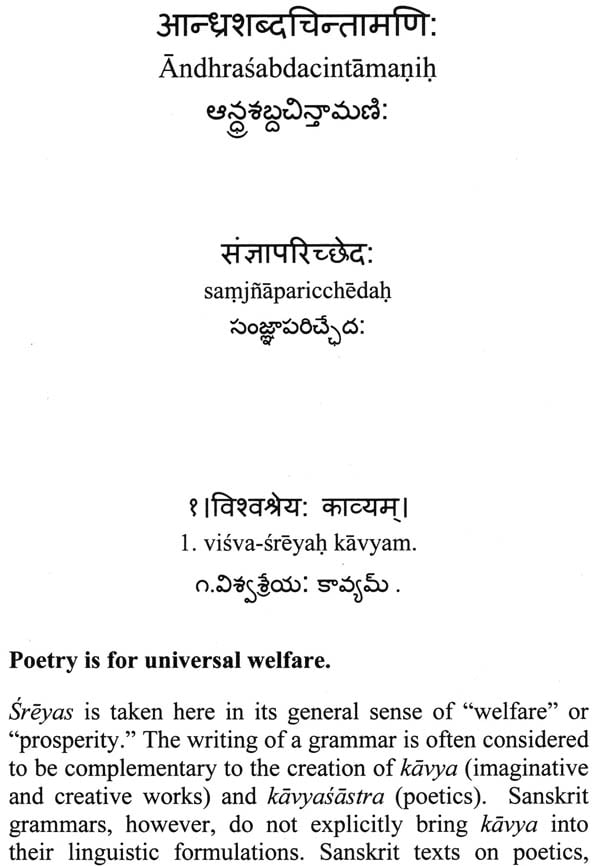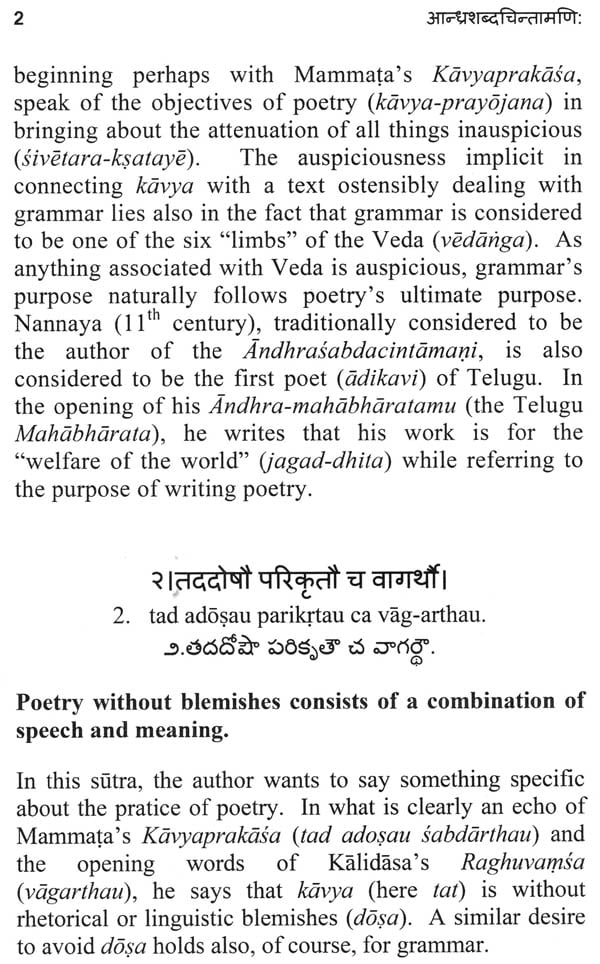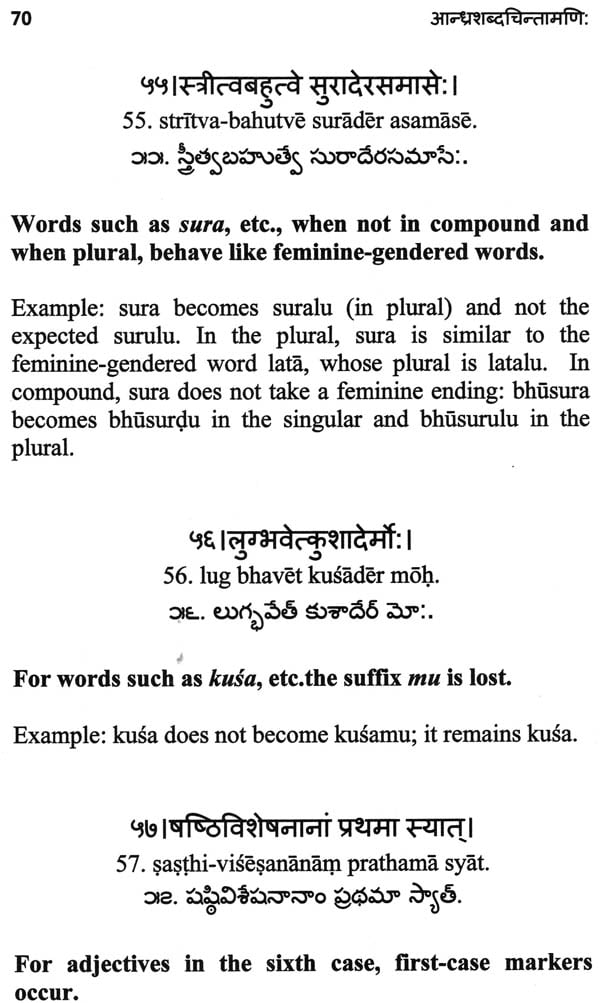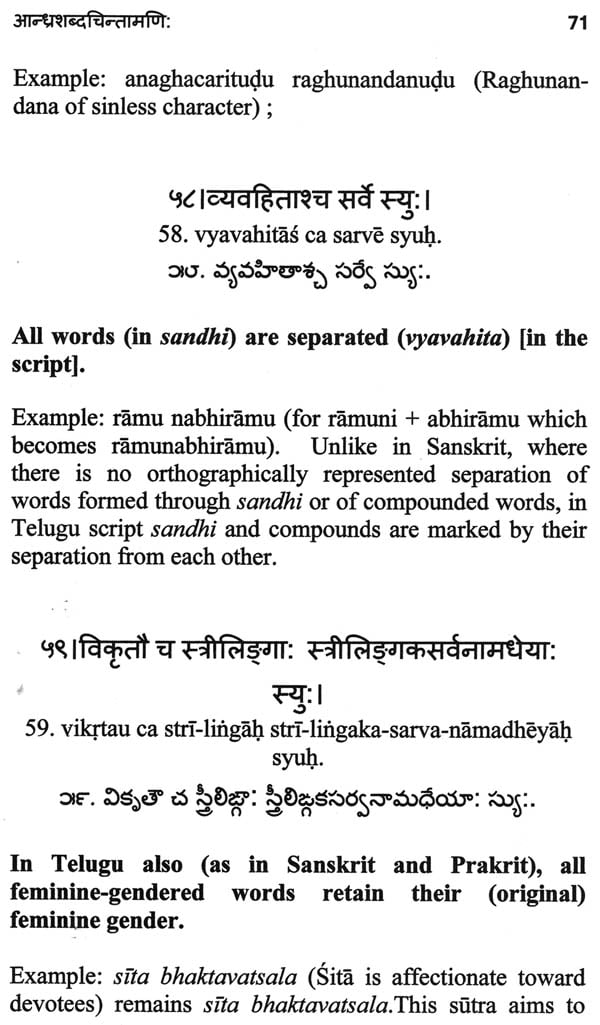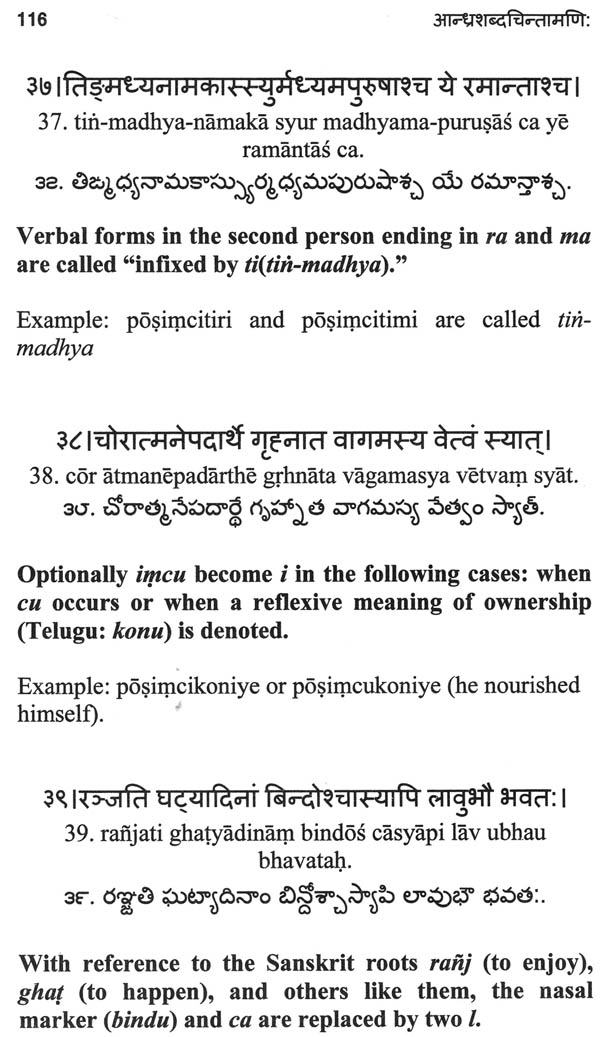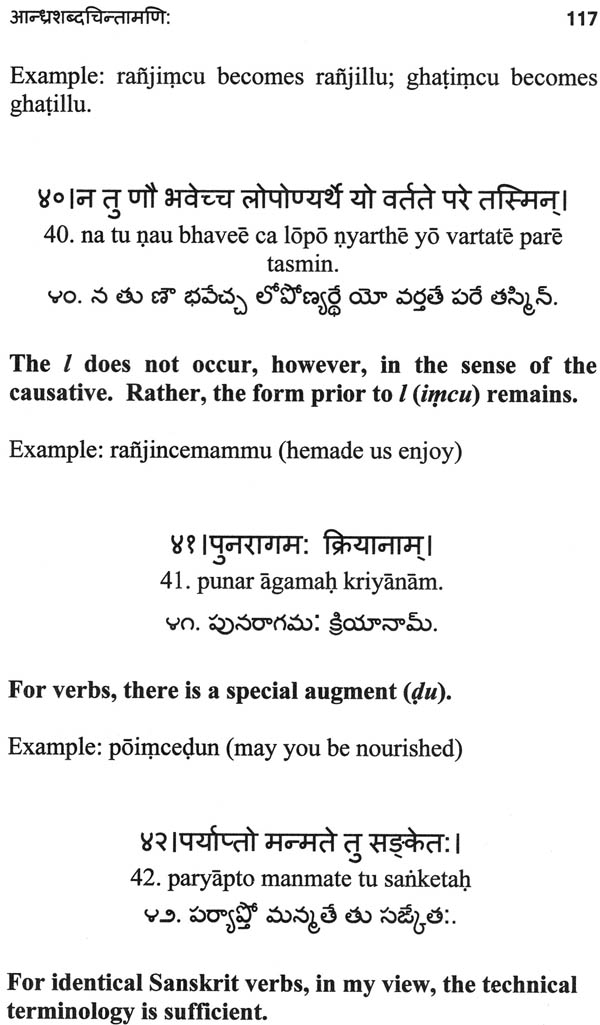
आन्ध्रशब्दचिन्तामणि: Andhrasabdacintamanih- A Grammar of the Telugu Language in Sanskrit
Book Specification
| Item Code: | NAW256 |
| Author: | R.V.S. Sundaram and Deven M. Patel |
| Publisher: | Central Institute Of Indian Languages, Mysore |
| Language: | Sanskrit Text with Telugu Transliteration and English Translation |
| Edition: | 2016 |
| ISBN: | 9788173431593 |
| Pages: | 132 |
| Cover: | PAPERBACK |
| Other Details | 8.50 X 5.50 inch |
| Weight | 200 gm |
Book Description
The Andhrasabdacintamani ["A treatise (literally: a wish-fulfilling gem) on Andhra speech-forms"] consists of two hundred and seventy four Sanskrit sutras that perfectly describe the Telugu language. Organized into five chapters that reflect the rich Sanskrit and Prakrit tradition of grammatical analysis, this work presents metalinguistic terminology that borrows from the work of India's ancient language experts from Panini onwards, develops "rules" of Telugu sandhi or sound coalescence, provides descriptions of Telugu nominal bases and verbal stems ending in vowels and consonants, and masterfully Andhrasabdacintamani may be the earliest grammar of the Telugu language, if we accept a tradition that attributes the text to the eleventh century poet-scholar Nannaya. Even if it is a later work, it stands as an enormously influential work that. shaped the growth of Telugu language and learning and, through its influence on the widely known Balavyakaranamu of Cintayasuri,-continues to have a role in the jog education system today. This edition and English translation of the Andhrasabdacintamani hopes to inaugurate a new stream of research on the important intersections of languages use and linguistics that have shapes the local cultures of Indian for the past one thousand years. The text has been given in Devnagari script, with Roman transliteration, and Telugu script. To supplement the English translation, an explanatory note for each sutra, along with examples, have been provided.
The central Institute of Indian Languages, Mysuru has been given the responsibility of establishing the Centre of Excellence for Studies in Classical Telugu (CESCT) to take up the academic and promotional activities of Classical Telugu. It is well known that Telugu has a long literary history of over one thousand years and invaluable treasure of great epics. The CESCT has been established with the objective to preserve and safeguard the literary contributions of great poets in the language and disseminate the knowledge among all the Telugu people around the world. The literature in Telugu represents a glorious tradition of scholarship and knowledge acquired through generations.
The CESCT is interested in spreading awareness about the rich classical tradition of Telugu among the younger generation. It has already conducted some workshops and a 21 day orientation course in collaboration with Dravidian University, Kuppam. It was a grand success and the participants included teachers, lecturers and research scholars.
As part of the activities, the Centre has taken up the publication of materials on Classical Telugu by eminent scholars. In this process we have taken up the publication of Andhrasabdachintamani, an ancient Grammar for Telugu written in Sanskrit. This text was translated into English by Prof. R.V.S. Sundaram, former professor of Telugu and Director, Kuvempu Institute of Kannada Studies, University of Mysore and Prof. Deven M. Patel, Associate Professor of Sanskrit, University of Pennsylvania, U.S.A. I thank both the authors for giving us an opportunity to publish this classical grammar. It gives me immense pleasure to publish this book being the first publication of the CESCT. I hope this book of grammar will spread the message enshrined in the invaluable classics.
One of the more remarkable yet understudied features of early India’s celebrated contribution to linguistic science is the regional-language grammar composed in Sanskrit. Early projects of Sanskrit grammar, especially the tradition inaugurated by Panini, is among the world’s great contributions toward developing procedures to describe a language in as comprehensive and condensed a manner as possible. Translating insights into phonology, morphology, syntax, and semantics that the Sanskrit (and, by extension, Prakrit) grammatical traditions open up and, more significantly, translating the procedures for presenting these insights, is a unique exercise taken up by regional-language experts in India and, as far as we can tell, exclusively limited to the linguistic milieu of early India. The exercise is an education in linguistic hermeneutics and shows the depth of multilingual consciousness in India. It is also a revelation of the trans-linguistic creativity that goes into adapting the procedures used to describe one language toward describing another (in some ways, altogether different) language, and to do it in the source language using that source language’s technical procedures of grammatical description. This volume—an English translation of a Telugu grammar composed in Sanskrit using the grammatical procedures of Sanskrit and Prakrit grammar—is the first ever published translation of one of these works.
The work at the heart of our discussion is the Andhrasabdacintamani,which may be the earliest grammar of the Telugu language. If it is a late work, we can say that it, at the least, attempts to describe the earliest usages of the Telugu language in the most unusual of ways: by composing it in Sanskrit and following the meta- discursive conventions of the A stadhyayi, Panini’s renowned grammar of Sanskrit, and the design of a host of later grammatical works that either reorganized or recreated Panini’s monumental work. The Andhrasabdachintamani [A treatise (literally: a wish-fulfilling gem) on Andhra speech-forms"] consists of two hundred and seventy four sutras and is organized into five chapters (pariccheda): samjia (metalinguistic terminology), sandhi (euphonic coalescence), ajanta (nominal bases/ verbal stems ending in vowels), halanta (nominal bases/ verbal stems ending in consonants), and kriya (verbal action). While the Andhrasabdacintamani closely follows Panini’s Astadhydayi in the construction of sutras and in its use of technical Paninian terms, the structuring of topics and explanations of grammatical issues show awareness of the Katantra grammar, Vararuci’s Prakr taprakasa, Hemacandra’s Siddhahaima- SabdanuSsasana, Kaccayana’s Pali grammar, and Bhattoji Diksita’s Siddhantakaumudi.
Authorship and Transmission of the Andhrasabdacintamani
The authorship and chronology of the text is obscure. While it is attributed to the great poet-scholar Nannaya Bhattu (eleventh century) by Telugu tradition, including Cinnayasiri, the nineteenth-century author of the very important Telugu grammar Balavyakaranamu, there are compelling arguments that it may have been actually composed as late as the seventeenth century.’Nannaya is considered the first Telugu poet and author of the grand Mahabharatamu, a version of the first two and a half sections (parva) of the Sanskrit Mahabharata. Because of its association with Nannaya, therefore, Telugu tradition offers a series of alternative names of the Andhrasabdacintamani that are based on the name or epithets associated with the poet: Nannayabhattiyamu, Vaganusasaniyamu, Sabdanu- Sasaniyamu, Prakriyakaumudi, Andhrakaumudi, and Andhravyakaranamu. Whatever its traditional authorship may be, the text and the title of the work as Andhrasabdacintamani was first introduced by Elakuchi Balasaraswathi (1590- 1670) as a part of his Telugu commentary to the Andhrasabdacintamani. Following tradition, Bala- Saraswathi also ascribed the authorship to Nannaya and related that the work was handed over to the great poet of Telugu by a siddha from the Matangamountain. Similarly, the seventeenth-century poet Appakavi reiterated the narrative of the siddha_ from the Matangamountain, further explaining that the siddha was none other than Sarangadhara, son of Rajarajanaréndra, the patron of Nannayain the eleventh century. Appakavi specifically mentions that the Andhrasabdacintamani was transmitted to Balasaraswathi in 1610 and then to himself in 1656. According to Balasaraswathi, apparently there were many commentaries of the Andhrasabdacintamani, composed in both Telugu and Sanskrit. He explains that there were five chapters to the text and that the work was composed in eighty-two verses in Gryd meter. It was Balasaraswathi who, while writing the commentary, divided the metrical verses into sutra for further analysis.
The Structure and Content of the Andhrasabdacintamani On the surface, it is not particularly startling that scholars of regional languages would incorporate and apply to their language the well-established technology formulated and executed by Panini and his predecessors to describe Sanskrit, and later Pali and Prakrit. The technology of linguistic description that Panini has contributed is, among other reasons, celebrated for its brevity and comprehensiveness: its condensation and rule- ordering logic, its reading words from earlier grammatical rules into succeeding ones (anuvrtti) or vice-versa (akarsana) to treat a topic concisely, its use of indicators (anubandha) and short technical terms (pratyahara) to signal morphophonemic changes, derivations, distinctions, and options to avoid confusion and ambiguity. All of these well-formed strategies have laid the groundwork for all grammatical work in India. What is intriguing about a text like the Andhrasabdacintamani, however, is the ways in which inherited techniques of linguistic description are integrated with ingenious innovations necessary to explain distinctive features of Telugu phonology, orthography, and in a startling turn, prosody, while also making pointed comments about the special identity of the Telugu language.
**Contents and Sample Pages**
